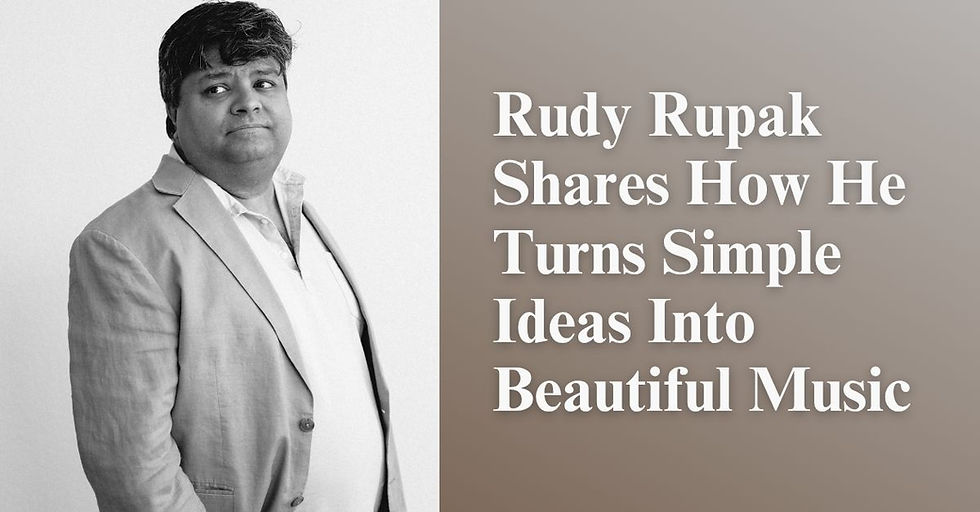Rudy Rupak Explores the Art of Storytelling Through Music
- Rudy Rupak
- Oct 29
- 3 min read

Introduction: Understanding Music as a Form of Storytelling
Storytelling has always been part of human culture, and music has served as one of its most powerful mediums. Rudy Rupak, a musician, composer, and songwriter, explores how music can communicate emotions, experiences, and ideas that words alone cannot express. His perspective highlights how melodies, harmonies, and rhythms can be structured to tell meaningful stories that resonate deeply with listeners.
Rudy believes that music and storytelling share the same foundation—both aim to connect people emotionally and intellectually. Each song, like a story, has a beginning, middle, and end, carrying the listener through an emotional journey.
How Music Tells a Story Without Words
Music tells stories through structure, tone, and emotion rather than sentences and dialogue. Rudy Rupak explains that elements such as tempo, melody, and rhythm act like the “language” of a story. For example:
Melody represents the main character or voice.
Harmony provides the setting and emotional background.
Rhythm gives pace to the story, reflecting how events unfold.
In instrumental music, these components guide listeners to feel specific emotions or imagine visual scenes. In lyrical compositions, the words and music work together to strengthen the story’s meaning. According to Rudy, this combination allows music to go beyond cultural or linguistic barriers, making it universally understandable.
Rudy Rupak’s Approach to Musical Storytelling
Rudy Rupak’s creative approach involves translating emotions into musical ideas. He often begins with an emotion or theme—such as love, hope, or loss—and then designs the soundscape around it. His goal is to make listeners feel as though they are experiencing a story through sound.
He also emphasises the importance of authenticity in storytelling. In his view, the strongest stories come from genuine emotions and personal experiences. Rather than following commercial trends, he focuses on writing music that expresses real human moments. This, he believes, helps the audience connect more deeply with the message behind each song.
Blending Cultures and Sounds to Enrich the Story
Rudy Rupak’s music often reflects a blend of cultural influences. He incorporates sounds, rhythms, and instruments from different traditions, creating a global storytelling experience. By doing this, he demonstrates how music can unify diverse cultures through shared emotion and understanding.
For example, using a mix of Indian classical instruments with Western harmonies allows Rudy to create unique stories that reflect both tradition and modernity. This combination not only enhances the musical texture but also expands the range of emotions that can be expressed.
Through this fusion, Rudy showcases how storytelling in music can cross boundaries, representing the interconnected world we live in today.
The Emotional Structure of a Song
Every song, according to Rudy Rupak, has an emotional structure similar to a written story.
The beginning introduces the tone or theme, setting up the listener’s expectations.
The middle builds tension or develops emotion, guiding the listener through conflict or discovery.
The ending resolves the story, leaving a lasting impression or message.
By structuring songs in this way, Rudy ensures that the listener remains emotionally engaged from start to finish. This approach helps music maintain its narrative flow and gives meaning to every section of a composition.
Why Storytelling Matters in Modern Music
In today’s digital era, where much of the music industry focuses on short attention spans and viral trends, Rudy Rupak reminds artists of the importance of storytelling. Listeners today crave authenticity and emotional depth—qualities that stories in music can provide.
He believes that storytelling through music can help people process emotions, understand complex experiences, and find comfort or inspiration. Music, when used as a storytelling tool, becomes more than entertainment; it becomes a form of connection and communication.
Moreover, songs with strong narratives tend to have longer-lasting appeal. They build emotional loyalty among listeners and create a sense of identity for the artist. Rudy’s insights show that storytelling remains essential for meaningful and sustainable music creation.
Conclusion: The Universal Language of Music and Story
Rudy Rupak’s exploration of musical storytelling reveals that every note has a purpose and every rhythm carries meaning. Through his creative process, he demonstrates how music can speak to emotions, connect cultures, and tell stories that words often fail to express.
By focusing on authenticity, emotional depth, and cultural blending, Rudy continues to inspire both musicians and listeners to view music as more than sound—it is a living story that unites people across time and place.




Comments